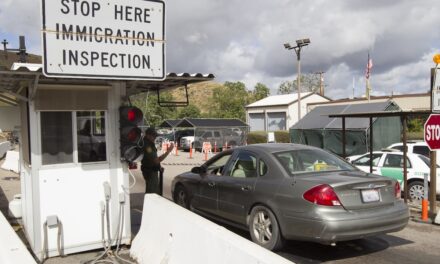We support our Publishers and Content Creators. You can view this story on their website by CLICKING HERE.
WARD, Colorado — Colorado’s Democrat governor responded to a concerned constituent who wrote in The Wall Street Journal about wolverine introduction by telling the author to build a fence to save her pets.
On Monday, Denver-area author and Federalist Senior Contributor Helen Raleigh published a letter to the editor in the Journal warning about the potential consequences of bringing wolverines back to the state, a policy the governor approved.
“Colorado Gov. Jared Polis recently signed a bill to reintroduce the vicious weasel known as the wolverine to the state,” Raleigh wrote. “What could go wrong? Plenty, if Colorado’s recent experience reintroducing the gray wolf is anything to go by.”
Raleigh went on to highlight the myriad issues that came up when the state brought back gray wolves following the passage of a 2020 ballot initiative, where “most of the ‘yes’ votes came from urban counties” such as Boulder and Denver. Residents in rural areas warned about the possible danger presented to livestock, tourists, and even the major cities. Gray wolves tracked with a GPS collar show they’ve quickly moved within roughly 80 miles of Denver after they were brought back four years ago.
“Wolverines are small, at most 40 pounds, but don’t let their size or their association with Hollywood heartthrob Hugh Jackman fool you. Wolverines are vicious killing machines,” Raleigh wrote. “They have been known to destroy animals much bigger than they are, including black bears.”
Polis replied to her concerns with a smug post on X, making a false comparison to the preexisting presence of bears and mountain lions “in our backyards.” So as Coloradans, we “know how to handle it.”
“Yes we get people who move here from the cities and east coast and they complain about wildlife, but they learn how to deal with the realities of living in the west soon enough,” he wrote. “And yes, the deer will eat your tulips if you don’t put up fencing.”
But setting aside the condescension of telling a constituent to “buy a fence” to protect her flowers from the “deer,” let’s take a look at how much it costs to border a “typical” Colorado home.
Homeowners in Denver typically pay up to roughly $4,000 for fence installation, with a cost of $13 to $56 for each linear foot of the perimeter, but they could pay as much as $54,000 per acre. Now expand that to ranchers in the rural communities, whose livelihoods are constantly threatened by wildlife, with an average acreage of more than 800. A rancher might not fence the entire property, but he’d still be looking at spending thousands per acre and tens or hundreds of thousands overall.
And yet, the governor’s snarky reply pointlessly escalated what began as a good-faith policy debate into a controversy wherein Raleigh began to receive dumb attacks online.
“Wolverines and wolves are different,” wrote one local radio host named Ross Kaminsky in a reply post. “Plus, wolverines saved the nation from a Soviet invasion if you remember your history.”
The Soviet reference is to the 1984 drama “Red Dawn” in which a group of guerilla fighters in Colorado called themselves the “Wolverines.” Kaminsky didn’t even address Raleigh’s arguments that wolverines are still uniquely deadly for both domesticated pets and livestock.
Other random commentators decided to depict Raleigh as someone who hates wildlife simply because she had the audacity to write about how to protect her own animals.
“If you don’t like wildlife, move to Chicago,” someone wrote.
But here’s Raleigh admiring a giraffe.
Wow, the image really captures the essence of a woman who despises nature. But in fact, Raleigh’s letter was in defense of animals to begin with. Wolverines are opportunistic predators most commonly hunting voles, squirrels, snowshoe hares, and birds, but supposed environmentalists never care about the birds that so often end up cracked open in flight by the blades of massive wind turbines. Wolverines can also kill moose and deer; and if they can take down giant moose at 12,000 pounds, they can tear apart sheep or even a dog far more efficiently than Kristi Noem can.
But while Polis suggests Raleigh is being hyperbolic about the threats to her “flowers,” some poser in Boulder added that she should “please act like a journalist and do even a little bit of research before writing.”
“There has [sic] only been two wolf attacks on a human in North America in the last 30 years,” wrote some photographer named “Nate Luebbe.” “You’re more likely to die of an infected hangnail than a wolf.”
But had Luebbe read Raleigh’s letter in The Wall Street Journal, he might have recognized that Raleigh wasn’t just talking about her neighbors’ lives. She was also writing about family animals and commercial livestock.
“Although wolverines naturally prefer to live in snow-packed mountain habitats and aren’t known to attack humans, the idea of a Coloradan going on a camping trip or a hike in the woods and encountering a wolverine — aka Satan’s lap dog — should terrify Mr. Polis,” she wrote. “A single incident could be politically deadly for the second-term Democrat with national ambitions. When a wolverine showed up near a Canadian high school in 2016, the school was locked down and the students let out only after it was determined that the skunk bear had departed.”
And to the governor’s point on Coloradans living harmoniously with bears and mountain lions with zero problems, it’s not entirely true. Last summer, a 35-year-old sheepherder was “severely injured” from a black bear attack in southwest Colorado. And in 2022, Colorado Parks and Wildlife received more than 4,000 sighting and conflict reports of bears seeking out trash, beehives, livestock, crops, or vehicles, resulting in 94 bears being euthanized.
Next door in Wyoming, ranchers have reported significant issues related to a booming population of grizzly bears that remain protected under federal law despite surpassing their target recovery numbers. Captures and relocations of problematic bears nearly doubled from 2020 to 2021, and landowners are increasingly anxious about the threats to pets and livestock over near-constant sightings.

 Conservative
Conservative  Search
Search Trending
Trending Current News
Current News 





